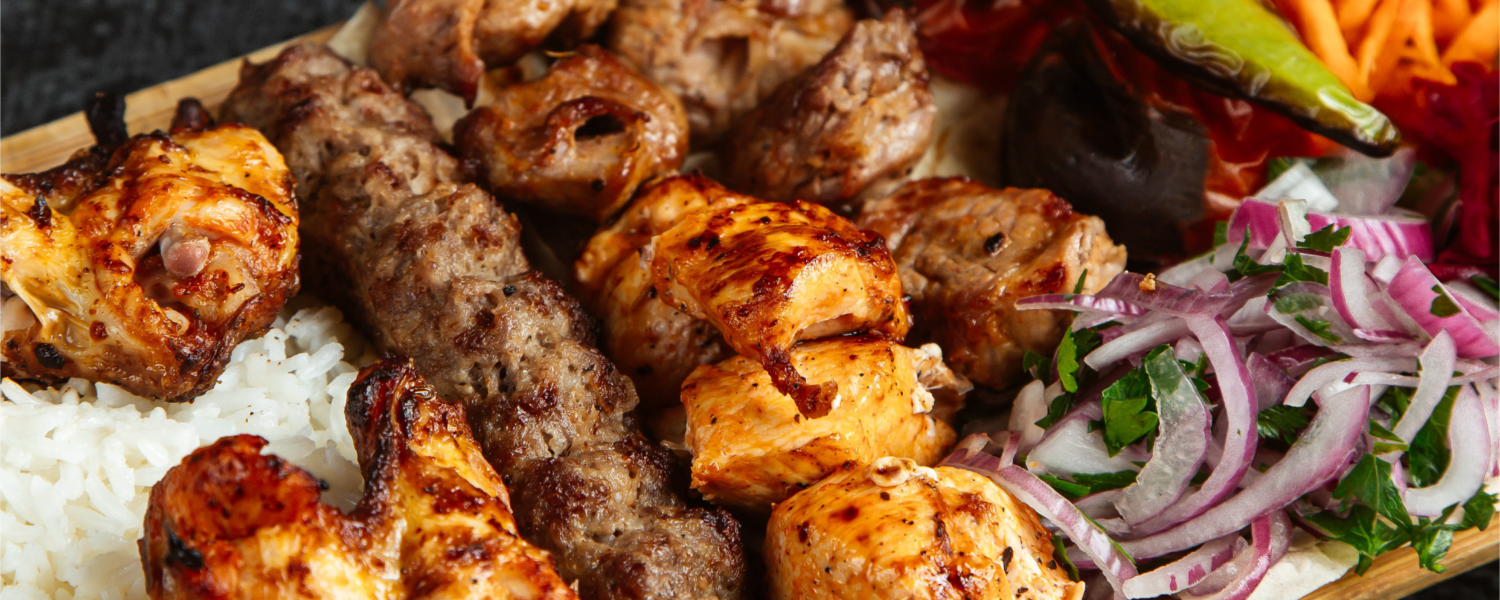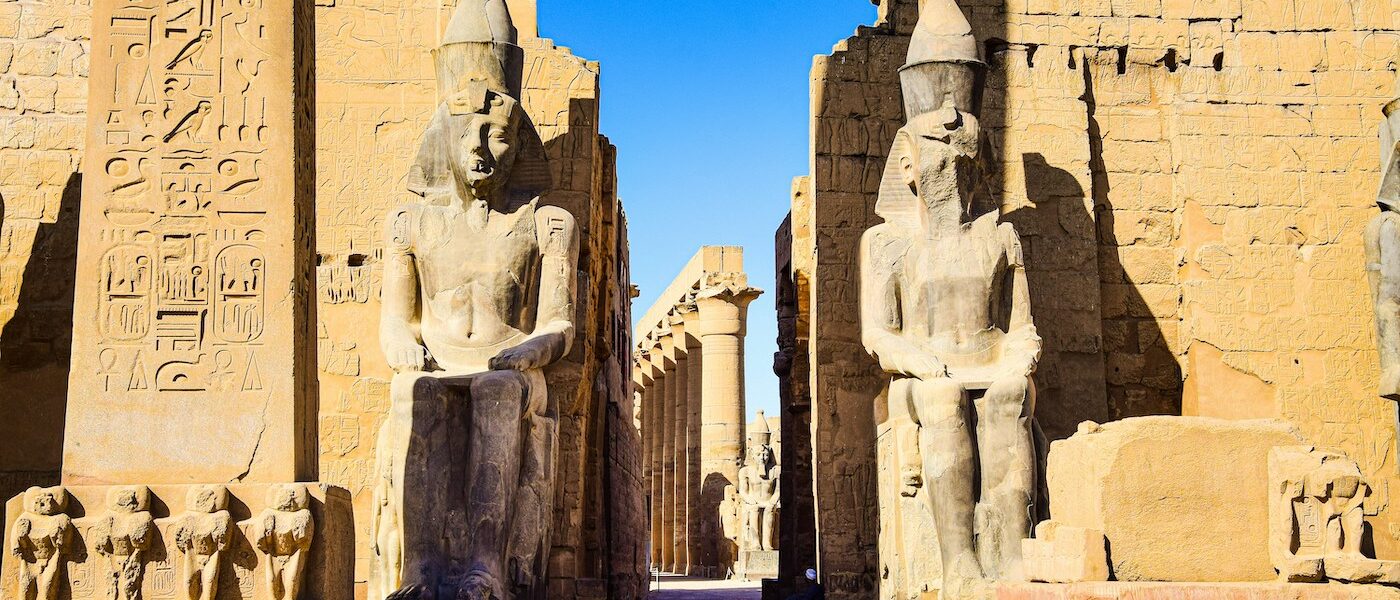Introduction to Traditional Egyptian Food
Traditional Egyptian food is a true delight for the taste buds and offers a variety for all tastes. Egyptian cuisine is a harmonious blend of Mediterranean and Middle Eastern flavors, combining fresh ingredients and aromatic spices to create unique dishes.
Vegetarians and meat lovers alike will find something to their liking among Egypt’s many traditional dishes. Whether you’re a fan of stuffed pigeons or sweet desserts, you’ll be delighted by Egypt’s culinary richness. Each dish tells a story and reflects the cultural and historical diversity of this fascinating region.
When planning your trip to Egypt, it’s essential to try at least a few traditional dishes. Even if you’re short on time, especially if you’re only staying for a week, here’s a selection of must-try dishes you shouldn’t miss.
Fattah: A Nutritious and Comforting Dish
Fattah, an iconic Egyptian dish, is enjoyed by all walks of life, from young to old. This delicious dish is primarily composed of meat soup, crispy bread, rice, and sauce. It is easy to prepare and is a culinary surprise for your friends and family. Eaten especially for breakfast during the holy month of Ramadan, fattah is appreciated for its high protein and carbohydrate content, providing a source of energy and vitality.
Fattah is commonly prepared for special occasions such as weddings or parties, where large numbers of guests are expected. Although the original recipe uses Aish Baladi bread, you can substitute it with any type of bread, including pita, white, wholemeal, or even toast. Its versatility and unique flavor make it a staple of Egyptian cuisine.
In addition to its delicious taste, fattah is also appreciated for its nutritional benefits. It is rich in essential nutrients and provides a balanced diet. By incorporating this dish into your diet, you not only enjoy authentic flavors but also numerous health benefits.
Koshari: Egypt’s Tasty Blend
Koshari is one of Egypt’s most distinctive dishes. It is often said that every Egyptian has eaten koshari at least once in their life. This dish is a savory mix of rice, lentils, chickpeas, and noodles, served with a garlic-infused tomato sauce and fried onions. Depending on taste, vinegar or a spicy tomato sauce can be added. Although the combination of ingredients may seem odd, koshari is extremely tasty and satisfying thanks to its high carbohydrate content.
Koshari is a staple food for many Egyptian families. Its low cost and simple ingredients make it a popular choice for everyday meals. Furthermore, it’s relatively easy to prepare, making it a convenient dish for both home cooks and experienced chefs. Exploring local markets and restaurants will reveal different variations of this classic dish, each offering a unique twist.
In addition to being delicious, koshari is also beneficial for your health. The lentils and chickpeas are rich in protein and fiber, while the rice and noodles provide sustained energy. This combination of ingredients makes koshari a balanced and nourishing meal, perfect for recharging your batteries after a day of exploring Egypt.
Egyptian Rice with Vermicelli: Daily Energy
Egyptian rice with vermicelli is a staple of Egyptian cuisine, often prepared daily in homes. This dish is not only delicious, but it is also essential for providing the body with necessary carbohydrates and energy. In Egypt, rice with vermicelli is often served as a side dish with many main dishes, adding a distinct texture and flavor to each meal.
Rice is an important source of energy, containing many carbohydrates, minerals, and vitamins that increase energy levels. Additionally, its low sodium content helps control blood pressure, while its high fiber content, especially in brown rice, protects against intestinal and rectal cancers. The skin benefits are also notable: rice soothes inflamed skin, reduces irritation, and lowers the risk of irritable bowel syndrome.
Additionally, Egyptian rice vermicelli helps reduce obesity when consumed in small amounts. A small portion of rice provides a feeling of fullness, which can help control appetite and reduce overall calorie intake. It is also low in cholesterol, sodium, and fat, making it a healthy choice for those watching their weight.
Falafel: Chickpea or Fava Bean Croquettes
Falafel, also known as tamiya in Egypt, are chickpea or fava bean croquettes that are deliciously crispy on the outside and soft on the inside. Popular throughout Arab countries, these croquettes are particularly popular in Egypt, where they are often eaten with ful medames (Egyptian fava beans), green tea, and Baladi Aish bread.
In Egypt, falafels are a staple of street food. Their unique texture and savory flavor make them a favorite among all generations. Prepared with fresh vegetables and spices, they are both nutritious and flavorful. Falafels are rich in protein and fiber, making them a healthy choice for a balanced meal.
Did you know? All Arab countries call this food falafel, except Egypt, where it’s known as tamiya. This slight linguistic difference reflects the richness and diversity of culinary traditions in the region. By tasting falafel in Egypt, you’re participating in an ancient and delicious tradition that unites cultures through shared flavors.
Baba Ganoush: Eggplant Puree Rich in Antioxidants
Baba Ganoush, also known as Mutabal, is a traditional eggplant puree popular in Egypt and many Arab countries. Easy to prepare, this rich and creamy puree is often eaten as an accompaniment to bread and vegetables. Eggplant, the main ingredient in this dish, is a rich source of antioxidants, which are beneficial for overall health.
Eggplants have numerous health benefits. They protect cells from free radical damage and prevent many chronic diseases. They also help prevent heart disease by improving heart function and reducing the severity of heart attacks. Baba Ganoush, with its simple yet nutritious ingredients, is an excellent addition to any balanced diet.
Eating baba ganoush also benefits from its positive effects on blood sugar regulation. Eggplant helps maintain normal blood sugar levels, preventing rapid fluctuations. Additionally, this dish is low in calories and high in dietary fiber, promoting a feeling of fullness and aiding in weight loss. The plant compounds found in eggplant can also fight cancer cells and prevent certain types of cancer.
Molokhia: Nutritious and Delicious Jute Soup
Molokhia, or Mulukhiyah, is a delicious soup very popular in Arab countries and much of Africa, although its origin is Egyptian. This soup is prepared from a plant called jute, which is extremely beneficial for our health. Molokhia is usually eaten with white rice or Arabic or pita bread, providing a complete and balanced meal.
Jute, the main ingredient in Molokhia, has numerous health benefits. It helps lower blood pressure and has diuretic properties, thus treating anxiety, stress, and depression. It also stimulates intestinal transit thanks to its cellulose fibers, helping to combat constipation. In addition, jute strengthens the immune system, making the body more resistant to disease.
Molokhia is also beneficial for skin and hair health. The antioxidants in jute protect against the symptoms of aging, such as the appearance of wrinkles, and promote rapid hair growth. Consuming this nutritious soup also strengthens your gums and improves the overall health of your skin. Finally, Molokhia helps treat anemia thanks to its iron content and promotes heart health by preventing osteoporosis.
Harissa: Spicy and Beneficial Sauce
Harissa is a hot sauce popular in most Arab countries, especially Morocco and Egypt. Besides being irresistible to those who love spicy food, this sauce is also very beneficial for our health. Harissa is made with red chilies, garlic, coriander, and caraway, delivering a burst of flavor in every bite.
Harissa is particularly valued for its health benefits. It helps lower LDL (bad) cholesterol and is ideal for
4o
diabetics, as it contains vitamin C and essential minerals. In addition, Harissa relieves joint pain, especially in the elderly, and has anticancer properties thanks to the capsaicin it contains. This sauce also aids digestion and helps burn fat, while protecting against atherosclerosis, sudden clots, paralysis, and diarrhea.
In Egypt, harissa is often used to enhance various dishes, adding a spicy and fragrant touch that invigorates the taste buds. It is also known to regulate heart rate and stimulate blood circulation, while protecting against Alzheimer’s disease. By incorporating this powerful sauce into your diet, you’ll not only enjoy its intense flavor but also its many health benefits.
Harissa can be consumed in a variety of ways: as a condiment to accompany meats, vegetables, or even soups. Its versatility makes it a valuable addition to any kitchen, and its power to enhance flavors makes it a must-have for those who enjoy spicy dishes. Exploring Egyptian markets, you’ll likely find different variations of this sauce, each with its own unique level of heat and flavor.
Shakshuka: A Complete and Tasty Breakfast
Shakshuka is a traditional Egyptian dish that is easy to prepare, attractive in appearance, and pleasant in aroma. This dish is particularly popular for breakfast, as it is a complete and nutritious meal, rich in protein and vitamins. Shakshuka consists of eggs poached in a spicy tomato sauce, often accompanied by vegetables such as peppers and onions, as well as spices such as cumin and paprika.
Shakshuka is not only delicious but also very beneficial for your health. Eggs are an excellent source of high-quality protein, which is necessary for the growth and repair of body tissues. They also contain essential vitamins such as vitamin B12, which helps maintain a healthy nervous system, and vitamin D, which is crucial for bone health. The tomato sauce, rich in antioxidants such as lycopene, helps reduce the risk of cardiovascular disease.
In Egypt, Shakshuka is often served with Baladi bread, allowing you to fully enjoy the savory sauce. This dish is also appreciated for its simplicity and speed of preparation, making it a perfect choice for a quick breakfast or brunch. The combination of flavors and textures in Shakshuka offers a unique culinary experience that will delight gourmets and lovers of traditional Egyptian cuisine.
Mombar: Egyptian Sausage Stuffed with Rice
Mombar, also known as Fawaregh or Kishke, is a veal sausage stuffed with a rice mixture and fried in oil. This delicious dish is typical of Egypt and is highly valued for its rich flavor and unique texture. Mombar is often prepared for special occasions, such as parties and celebrations, where it is served in large quantities to delight guests.
The process of preparing Mombar is meticulous and requires a certain culinary expertise. The calf intestines are carefully cleaned and stuffed with a mixture of spiced rice, tomatoes, onions, and herbs. Once stuffed, the Mombar are deep-fried until golden brown and crispy on the outside, while remaining tender on the inside. The result is a dish rich in flavor and nutrients, perfect for a feast.
Mombar is also beneficial for health, as it is rich in protein and complex carbohydrates, providing a sustainable source of energy. In addition, the rice and vegetables used in the filling provide dietary fiber, aiding digestion and intestinal health. By tasting Mombar, you are enjoying a traditional dish deeply rooted in Egyptian culture, offering an authentic and memorable gastronomic experience.
Fiteer: Multi-Layer Egyptian Pancakes
Fiteer, also known as Egyptian pancakes, is made up of many layers of thin dough, resembling a pastry more than a traditional crepe. Fiteer can be filled with various sweet or savory fillings, and some versions can even be dusted with powdered sugar for a unique, sweet taste. Savory versions can be topped like a pizza and then grilled, offering a wide variety of flavors and textures.
Fiteer is usually served in one piece, but it remains a very practical and tasty type of street food. You can enjoy it with sweet toppings like honey, sugar, or chocolate, or savory toppings like cheese, meat, or vegetables. This flexibility makes Fiteer a dish enjoyed by everyone, regardless of tastes and preferences.
When visiting Cairo, you’ll find some of the best restaurants serving Fiteer at the Tawfiqiyya Souq, the city center’s fruit and vegetable market, which is usually open from early morning until after midnight. This vibrant market offers an authentic culinary experience, where you can enjoy freshly prepared dishes and discover the richness of Egyptian cuisine.
Food: A Glimpse of Egyptian Culture
Food in Egypt is not just a means of subsistence, but a profound reflection of the country’s culture and traditions. Since ancient times, Egyptians have developed a rich and varied cuisine, influenced by local resources and cultural exchanges with other regions of the world.
Beer in Ancient Egypt
Modern Egypt is very conservative, but in ancient times, Egyptians consumed large quantities of beer. One of the main reasons was that drinking water was not as readily available as it is today. Beer, safer than river water, was brewed primarily to quench thirst. Even today, beer in Egypt is primarily made from barley and is very light, providing a refreshing drink in the country’s hot climate.
Good Table Manners
Table etiquette varies across the country and depends on the region. About 90% of Egyptians are Muslim, and it is important for visitors to follow certain guidelines. The left hand is considered impure and should not be used for eating. Additionally, it is best not to ask about alcohol or pork, and to keep your feet under the table while eating.
Meat: A Luxury in Egypt
In the past, meat was very expensive and rarely used in everyday cooking. Traditional Egyptian cuisine consists mainly of vegetables. Being invited to a meal where meat is served is a great honor. Egypt is an ideal destination for vegetarians, as it offers a wide variety of rich and delicious meat-free dishes.
Food as Currency
Archaeologists have discovered that food was used as currency during the ancient Egyptian era. Workers were often paid in food and drinks, such as bread and beer. Standardized sizes and recipes existed to ensure uniform values. Traders and tax collectors could be paid in grain, demonstrating the importance of food in the economy and society of the time.
The Growth of the Restaurant Sector in Cairo
Since 2011, more than 6,000 restaurants have opened in Cairo, reflecting the booming restaurant industry in the Egyptian capital. More and more foodies are using their e-Visa to visit Cairo, attracted by Egyptian cuisine, which has evolved significantly in recent years. The growing demand for new culinary concepts has led to the emergence of many exciting restaurants that fuse old and new.
Fattah: A Dish for Special Occasions
Fattah is an incredibly tasty and high-calorie dish, commonly served at religious festivals and Egyptian weddings. Consisting of fried bread topped with rice, a piece of meat, and vinegar soup, followed by tomato sauce and larger pieces of meat, Fattah is rarely seen outside of special occasions. If you have the opportunity to try this dish, don’t miss it.
The Generosity of the Pharaohs
In ancient Egypt, pharaohs ensured that no one starved to death. Grain was stored centrally and shared with the poor. People were also free to fish in the rivers and hunt game, demonstrating the spirit of generosity and sharing that still characterizes Egyptian culture today.
Egyptian food is a journey through history and traditions. By tasting these dishes, you will discover not only unique flavors but also a glimpse into Egyptian culture and hospitality. Enjoy every bite and let yourself be carried away by the richness of Egyptian cuisine.







